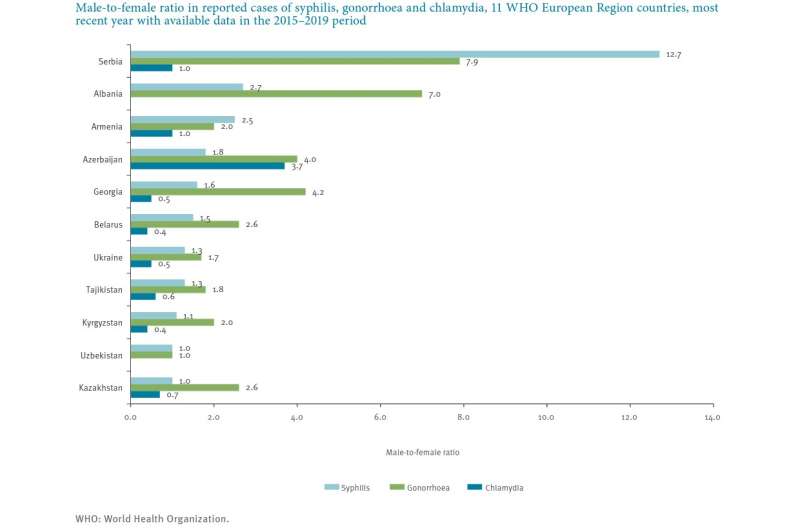Epidemiology of syphilis, gonorrhea and chlamydia in the Centre and East part of the WHO European Region

In their article published in Eurosurveillance, Bozicevic et al. analyzed data on reported cases of syphilis, gonorrhea and chlamydia for the period 2015 to 2019 from 18 non-EU/EEA countries of the World Health Organization's European Region. During this time, the number of reported cases per 100,000 population was 0.4–26.5 for syphilis, 0–18.5 for gonorrhea and 0–43.3 for chlamydia.
In contrast to the countries of the European Union and European Economic Area (EU/EEA), in most of the non-EU/EEA countries of the Region with three or more data points in the period 2015 to 2019 there seem to be decreasing trends in reported cases of syphilis, gonorrhea and chlamydia.
Among the reporting countries, Georgia observed the highest syphilis case rate in the last included year (2018 or 2019 depending on data availability) with 26.5 cases per 100,000 population, followed by Kazakhstan (18.8/100,000) and the Russian Federation (16.6/100,000). In comparison, EU/EEA countries had a crude notification rate of syphilis of 7.0 per 100,000 population in 2018. The highest rates were recorded in Malta (17.9/100,000), Luxembourg (17.1/100,000) and the United Kingdom (12.6/100,000).
Higher proportion of men with syphilis and gonorrhea
Georgia also had the highest rate of reported chlamydia and gonorrhea cases in the last included year (2018 or 2019) with 52.0 per 100,000 chlamydia cases and 18.5 per 100,000 respectively. Belarus had a chlamydia notification rate of 43.3 per 100,000 and the Ukraine of 31.6 per 100,000. Gonorrhea rates were above 10 per 100,000 population in Kazakhstan and Uzbekistan with a pattern of decrease in the most recently reported rates in the countries that had available data for at least 3 years, with the exception of Azerbaijan.
While most of the countries reported more cases of syphilis and gonorrhea in men than in women, chlamydia cases in women outnumbered those in men in the majority of countries.
In the period from 2015 to 2018, only four non-EU/EEA countries reported antimicrobial resistance and susceptibility testing data of at least one drug to the Gonococcal Antimicrobial Surveillance Programme, namely Belarus, Kyrgyzstan, the Russian Federation and Ukraine.
The authors note a still rather limited availability of sexually transmitted infections (STI) data in the Centre and Eastern part of the WHO European Region, including AMR data in gonococci. This influences comparability with available STI data from EU/EEA. They advocate for improved availability and quality of STI surveillance data "so as to better estimate the burden of STI, measure progress towards the STI control targets set by the WHO and guide the implementation of national STI control programs."
More information: Jelena Barbaric et al, Surveillance and epidemiology of syphilis, gonorrhoea and chlamydia in the non-European Union countries of the World Health Organization European Region, 2015 to 2020, Eurosurveillance (2022). DOI: 10.2807/1560-7917.ES.2022.27.8.2100197



















